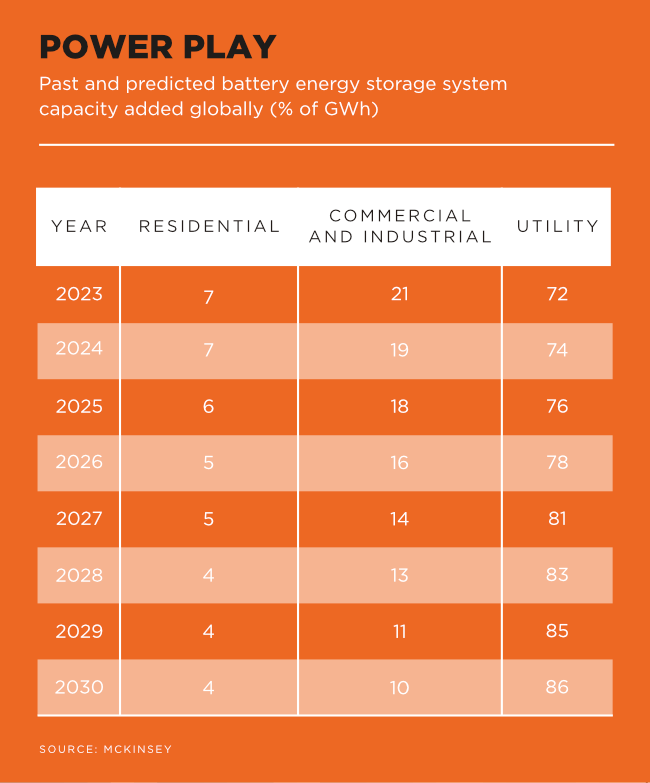Form Energy, a US start-up firm, recently revealed its plans to build the world’s biggest battery. The project – located in Maine, in sleepy New England – will be capable of storing 8 500 MWh of energy, which is enough to power an electric car for 50 million km or 1 228 trips around the world. Or, given that the average laptop has about 65 Wh capacity, Form Energy’s facility will have 130 million times the energy capacity of the device used to write this article.
It’s not perfect. The low turnaround efficiency (with losses of about 50%) means that it may not be economically viable in the long run. However, it’s a sign of how large-scale battery storage is maturing as a technology.
‘It’s definitely the technology of the future, and with more investment and greater capacity being built, the cost curve is also sloping down,’ Holger Rothenbusch, MD and head of infrastructure and climate at British International Investment, said in a recent interview. ‘I would expect that by 2030 battery costs are going to be cost competitive, compared to thermal alternatives.’
Battery storage also holds enormous potential for Africa. Speaking to CNBC Africa in April, the UK’s High Commissioner to SA, Antony Phillipson, confirmed an investment of more than $300 million to finance Red Sands, the continent’s largest battery storage system, located in the sunny Northern Cape.
‘This is a significant investment in South Africa’s future,’ said Phillipson. ‘This will be the biggest standalone battery energy storage system anywhere in Africa and it will also make […] a really significant contribution to SA’s just energy transition.’
The Red Sands project is just one example. Richard von Moltke, GM at Static Power, a division of global energy solution provider ACTOM, says energy storage is crucial for SA’s energy goals, particularly in ensuring stable grids and integrating renewables. ‘While the country has great renewable energy sources, the problem is its load profile that does not align with the renewable energy generation profile,’ he explains.
‘Hence, we need energy storage solutions to store energy during peak generation time, when there is lower demand. Excess energy produced during peak generation periods should be stored in energy storage systems and dispatched during high-demand periods, which will ensure a more efficient energy network. Yet, this is where we have a problem in South Africa because in areas of the highest solar irradiance, where solar PV projects are most economical, we have grid capacity constraints and a lack of energy storage solutions.’
Like, for example, in the Northern Cape. Nonetheless, utility-scale battery storage is growing ‘in leaps and bounds’, according to Dwibin Thomas, cluster automation leader at Schneider Electric. He points to US Energy Information Administration estimates that see it reaching 30 GW by 2025. ‘This remarkable growth in battery storage capacity is outpacing even the early growth of the US’ utility-scale solar capacity,’ he says. ‘In South Africa, utility-scale batteries offer a stable storage solution particularly with more independent power providers [IPPs] entering the market and providing renewable energy to alleviate strain on the traditional grid,’ he says. ‘Here, it is vitally important that storage such as lithium-ion batteries form part of the energy provision mix from the get go. Renewables are intermittent, and if it is backed up by battery storage it will allow IPPs to provide stable supply.’
Across SA, households have been forced to invest in small-scale battery storage to keep the lights on (and the laptops powered) through load shedding. Portable solutions from Jackery, EcoFlow, Anker and Gizzu have powered many a dark winter’s night and Stage 6 day. But while battery storage makes sense at a household level, this hasn’t translated to a utility level.
‘Load shedding has forced the country to transition very quickly to accepting energy storage solutions in behind-the-meter applications,’ says Von Moltke. ‘However, it has been a far harder sell when it comes to commercial and industrial consumers because, depending on the type of load and the number of hours of back-up they need, the return on investment can be between five and eight years with solar PV included.’
Here Von Moltke draws an important differentiation between two segments: in-front-of-the-meter systems and behind-the-meter systems. ‘These segments have different timelines, approaches and resource pools, but both are equally important for the country’s transition,’ he says. ‘Behind-the-meter systems are typically smaller and usually fall into the private sector space, such as residential, commercial, and industrial systems. These systems are quicker and easier – although still complex – to instal and could have a faster impact on South Africa’s transition. This impact of distributed systems has already been seen over the past three years with the proliferation of solar PV installations, mainly by small businesses and residential users.’
Meanwhile, Von Moltke explains, in-front-of-the-meter systems are utility-scale projects, driven by Eskom and/or power utilities or IPPs. These, he says, tend to be long-term projects that could take four to six years or more to complete.
‘While both are crucial to South Africa’s energy transition, behind-the-meter solutions provide immediate relief to the country’s energy constraints. In-front-of-the-meter projects are key to meeting actual energy transition targets and reducing emissions. These are typically large sustainable projects that will enhance the larger grid infrastructure utilisation and ultimately assist to reduce the reliance on coal power stations,’ he says.
Here Thomas provides some clarity on the technical aspects. ‘Utility-scale battery storage, like any residential system, requires a sophisticated energy management system [EMS] to provide insight into daily usage, provision, supply and so forth,’ he says. ‘It therefore consists of hardware and software components. The hardware includes battery modules, battery racks, protection devices and inverters which convert the direct current of the battery into the alternating current of the coupled power grid.’
The key software components, meanwhile, are the EMS, the battery management system (BMS) and a supervisory control and data acquisition system (SCADA).
‘The EMS acts as a higher-level operating system that integrates to external systems and manages the response to changes in demand and supply,’ says Thomas. ‘The function of the BMS is to monitor the performance data of the battery modules and to regulate their charging and discharging. The SCADA controls and monitors all the processes of the battery system in real-time while collecting data on the system’s performance, such as voltage, current and temperature, and provides alerts if there are any issues. Lastly – and this an important benefit – battery storage can provide power to the grid in a matter of seconds, allowing for a seamless switchover between distributed energy resources and importantly providing stable supply to users.’
So, how close are we to seeing utility-scale battery storage facilities? Form Energy’s enormous project in Maine may be a few years from operation (and many more years from practicality and profitability), but the reality is that costs for these facilities are falling – and as they do, the balance of power is shifting.
‘The combination of solar [PV] and batteries is today competitive with new coal plants in India,’ International Energy Agency executive director Fatih Birol recently told Reuters. ‘And just in the next few years, it will be cheaper than new coal in China and gas-fired power in the United States. Batteries are changing the game before our eyes.’










